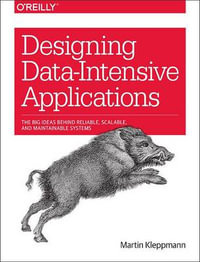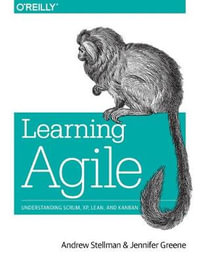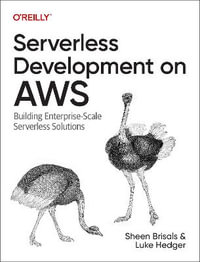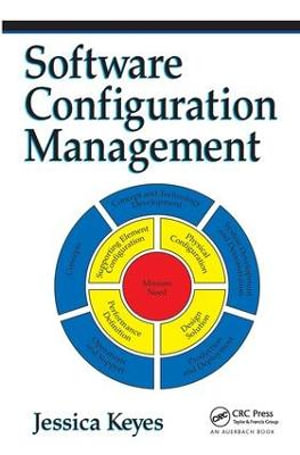
At a Glance
638 Pages
24.9 x 17.3 x 2.1
Hardcover
RRP $252.00
$178.40
29%OFF
or 4 interest-free payments of $44.60 with
orAims to ship in 7 to 10 business days
Software Configuration Management discusses the framework from a standards viewpoint, using the original DoD MIL-STD-973 and EIA-649 standards to describe the elements of configuration management within a software engineering perspective.
Divided into two parts, the first section is composed of 14 chapters that explain every facet of configuration management related to software engineering. The second section consists of 25 appendices that contain many valuable real world CM templates.
The content is extensive and inclusive, covering everything from CM planning to configuration identification, verification, and auditing. Although it is vendor-neutral, it offers a serious discussion of what to look for in a CM tool and lists toolsets for review. This volume is a sourcebook of techniques, templates, and best practices in the field, providing software engineers and systems developers with what they need to run a successful CM program.
Industry Reviews
| Foreword | p. xv |
| Preface | p. xvii |
| Introduction to Software Configuration Management | p. 1 |
| SCM and Process Improvement | p. 3 |
| Measurements and Metrics | p. 5 |
| Benefits of SCM | p. 6 |
| SCM Components | p. 7 |
| Configuration Identification | p. 8 |
| Configuration Change Control | p. 10 |
| Configuration Status Accounting | p. 13 |
| Configuration Auditing | p. 14 |
| Implementing SCM in the Organization | p. 15 |
| Manage the Risks of SCM | p. 16 |
| Summary | p. 18 |
| Project Management in a CM Environment | p. 23 |
| Who Writes the Project Plan | p. 26 |
| What Goes Into the Project Plan | p. 26 |
| CM-based Project Plan Components | p. 28 |
| Identification | p. 28 |
| Software Scope | p. 30 |
| Project Estimates | p. 30 |
| Estimation Techniques | p. 30 |
| Decomposition Techniques | p. 33 |
| Empirical Model | p. 33 |
| Risk Management Strategy | p. 33 |
| Risk table | p. 34 |
| RMMM plan for each risk | p. 34 |
| Schedules | p. 34 |
| Resource table | p. 38 |
| Project Resources | p. 38 |
| Tracking and Control Mechanisms | p. 40 |
| Quality Assurance and Control | p. 40 |
| Change Management and Control | p. 41 |
| Performance Measurement | p. 41 |
| Configuration Status Accounting | p. 42 |
| Summary | p. 43 |
| The DoD CM Process Model | p. 45 |
| CM Benefits, Risks, and Cost Impact | p. 46 |
| CM Life-Cycle Management and Planning | p. 48 |
| Management and Planning | p. 48 |
| Configuration Identification | p. 49 |
| Configuration Control | p. 50 |
| Configuration Status Accounting (CSA) | p. 50 |
| Configuration Verification and Audit | p. 51 |
| Relation to Systems Engineering Process | p. 51 |
| Implementing the CM Process | p. 55 |
| Measuring and Evaluating the CM Process | p. 56 |
| CM Benefits and Risks by Program Life-Cycle Activity | p. 58 |
| Management and Planning: Concept and Technology Development Phase | p. 58 |
| Configuration Identification: Concept and Technology Development Phase | p. 58 |
| Configuration Control: Concept and Technology Development Phase | p. 59 |
| Configuration Status Accounting: Concept and Technology Development Phase | p. 60 |
| Management and Planning: System Development and Demonstration Phase | p. 60 |
| Configuration Identification: System Development and Demonstration Phase | p. 61 |
| Configuration Control: System Development and Demonstration Phase | p. 62 |
| Configuration Status Accounting: System Development and Demonstration Phase | p. 63 |
| Configuration Audit: System Development and Demonstration Phase | p. 64 |
| Management and Planning: Production and Deployment Phase | p. 65 |
| Configuration Identification: Production and Deployment Phase | p. 66 |
| Configuration Control: Production and Deployment Phase | p. 66 |
| Configuration Status Accounting: Production and Deployment Phase | p. 67 |
| Configuration Audit: Production and Deployment Phase | p. 69 |
| Management and Planning: Operations and Support Phase | p. 69 |
| Configuration Identification: Operations and Support Phase | p. 70 |
| Configuration Control: Operations and Support Phase | p. 70 |
| Configuration Status Accounting: Operations and Support Phase | p. 71 |
| Effect Process Improvement and Document Lessons Learned | p. 72 |
| Summary | p. 72 |
| Configuration Identification | p. 75 |
| How Configuration Identification Works | p. 75 |
| Configuration Identification General Activity Guides | p. 78 |
| Product Structure | p. 78 |
| Configuration Items | p. 78 |
| Configuration Item Selection Criteria | p. 82 |
| General Guidance | p. 82 |
| CI Selection Checklist | p. 83 |
| Additional Factors | p. 84 |
| Configuration Documentation | p. 86 |
| Specification Types Categorized by Object | p. 86 |
| System | p. 86 |
| Item | p. 86 |
| Software | p. 87 |
| Process | p. 87 |
| Specification Types Categorized by Purpose | p. 87 |
| Performance | p. 87 |
| Detail | p. 87 |
| Design Solution Document Concepts | p. 88 |
| Software Documentation List | p. 89 |
| Process Implementation: Planning | p. 89 |
| System Requirements Analysis and Architectural Design | p. 89 |
| Software Requirements Analysis and Design | p. 89 |
| Software Architectural and Detailed Design | p. 90 |
| Software Integration and Qualification Testing | p. 90 |
| As-Built Software Product Definition | p. 90 |
| System Operation | p. 90 |
| System/Software Maintenance | p. 91 |
| Configuration Baselines | p. 91 |
| Configuration Baseline Concepts | p. 91 |
| Document and Item Identification | p. 94 |
| Part/Item Identification Numbers (PIN) | p. 96 |
| Software Identifiers | p. 96 |
| Engineering Release | p. 97 |
| Interface Management | p. 97 |
| Summary | p. 99 |
| Configuration Control | p. 101 |
| The Process of Configuration Control | p. 101 |
| Engineering Change Proposal | p. 103 |
| Request for Deviation | p. 103 |
| RFD Contents | p. 113 |
| Summary | p. 113 |
| Configuration Status Accounting | p. 115 |
| Typical CSA Information over the Acquisition Program Life Cycle | p. 116 |
| Concept and Technology Development | p. 118 |
| System Development and Demonstration | p. 118 |
| Production and Deployment | p. 119 |
| Operational Support | p. 120 |
| Configuration Status Accounting Process Evaluation Checklist | p. 120 |
| Summary | p. 121 |
| A Practical Approach to Documentation and Configuration Status Accounting | p. 123 |
| Configuration Identification | p. 123 |
| Product Structure | p. 124 |
| Product Identifiers | p. 124 |
| Baselines | p. 125 |
| Configuration Status Accounting | p. 125 |
| The Effective Documentation of Systems | p. 126 |
| Methods and Standards | p. 130 |
| Generating Documentation the Right Way | p. 132 |
| All Documentation Produced prior to the Start of Code Development | p. 132 |
| Program Flowcharts | p. 132 |
| Use or Business Cases | p. 132 |
| Terms of Reference | p. 136 |
| Data Dictionary | p. 137 |
| Program/Component/Object Documentation | p. 137 |
| All Presentation Material | p. 138 |
| Test Cases (Appendix E) and Test Plan | p. 138 |
| Metrics | p. 139 |
| Operations Instructions | p. 139 |
| End-User Help Files | p. 140 |
| User Documentation | p. 140 |
| Maintaining Documentation | p. 140 |
| Summary | p. 143 |
| Configuration Verification and Audit | p. 145 |
| Configuration Verification and Audit Concepts and Principles | p. 146 |
| Configuration Verification | p. 147 |
| Configuration Audit | p. 149 |
| Functional Configuration Audit | p. 149 |
| Physical Configuration Audit | p. 150 |
| Application of Audits during Life Cycle | p. 150 |
| Summary | p. 151 |
| A Practical Approach to Configuration Verification and Audit | p. 157 |
| Components of a Design and Document Verification Methodology | p. 157 |
| Components of a Configuration Audit Methodology | p. 158 |
| Components of a Testing Methodology | p. 159 |
| Inspections | p. 160 |
| Walk-Throughs | p. 160 |
| Unit Testing | p. 161 |
| Daily Build and Smoke Test | p. 161 |
| Integration Testing | p. 163 |
| System Testing | p. 163 |
| Parallel Testing | p. 164 |
| The QA Process | p. 164 |
| The Test Plan | p. 164 |
| Test Automation | p. 166 |
| Summary | p. 171 |
| Configuration Management and Data Management | p. 173 |
| CM-Related Data Management Concepts and Principles | p. 174 |
| Document Identification | p. 175 |
| Data Status Level Management | p. 177 |
| Data and Product Configuration Relationships | p. 178 |
| Data Version Control | p. 179 |
| Digital Data Transmittal | p. 180 |
| Data Access Control | p. 181 |
| Summary | p. 182 |
| Configuration Change Management | p. 183 |
| What Is Configuration Change Management? | p. 183 |
| The Maintenance Process | p. 184 |
| The Product Baseline | p. 186 |
| Types of Maintenance | p. 186 |
| Corrective Maintenance | p. 186 |
| Adaptive Maintenance | p. 187 |
| Perfective Maintenance | p. 187 |
| Preventive Maintenance | p. 187 |
| Maintenance Costs | p. 187 |
| A Model for Maintenance | p. 188 |
| Configuration Management Steps | p. 189 |
| Change Identification | p. 189 |
| Evaluation and Coordination | p. 191 |
| Change Implementation and Verification | p. 193 |
| Handling Variances | p. 194 |
| Managing Maintenance Personnel | p. 194 |
| Measuring Effectiveness | p. 194 |
| Summary | p. 195 |
| Configuration Management and Software Engineering Standards Reference | p. 197 |
| The Standards Bodies | p. 199 |
| A Summary of the EIA Standard (EIA-649) | p. 200 |
| Configuration Management Planning and Management | p. 200 |
| Configuration Identification | p. 201 |
| Configuration Change Management | p. 202 |
| Configuration Status Accounting | p. 203 |
| Configuration Verification and Audit | p. 203 |
| Management of Digital Data | p. 204 |
| ANSI | p. 204 |
| IEEE | p. 205 |
| IEEE Software Engineering Standards Summary | p. 205 |
| ISO | p. 205 |
| ISO Software Engineering Standards Summary | p. 205 |
| Summary | p. 237 |
| Metrics and Configuration Management Reference | p. 239 |
| What Metrics Are and Why They Are Important | p. 240 |
| Traditional CM Metrics | p. 242 |
| IEEE Process for Measurement | p. 242 |
| Plan Organizational Strategy | p. 243 |
| Determine Software Reliability Goals | p. 244 |
| Implement Measurement Process | p. 244 |
| Select Potential Measures | p. 244 |
| Prepare Data Collection and Measurement Plan | p. 244 |
| Monitor the Measurements | p. 245 |
| Assess Reliability | p. 245 |
| Use Software | p. 245 |
| Retain Software Measurement Dat | p. 246 |
| Metrics as a Component of the Process Maturity Framework | p. 246 |
| Initial Process | p. 246 |
| Repeatable Process | p. 246 |
| Defined Process | p. 247 |
| Managed Process | p. 247 |
| Optimizing Proces | p. 248 |
| Steps to Take in Using Metrics | p. 248 |
| IEEE Defined Metrics | p. 249 |
| Fault Density | p. 249 |
| Defect Density | p. 249 |
| Cumulative Failure Profile | p. 250 |
| Fault-Days Number | p. 250 |
| Functional or Modular Test Coverage | p. 250 |
| Requirements Traceability | p. 250 |
| Software Maturity Index | p. 251 |
| Number of Conflicting Requirement | p. 251 |
| Cyclomatic Complexity | p. 252 |
| Design Structure | p. 252 |
| Test Coverage | p. 253 |
| Data or Information Flow Complexit | p. 253 |
| Mean-Time-to-Failure | p. 254 |
| Software Documentation and Source Listings | p. 254 |
| IT Developer's List of Metrics | p. 255 |
| McCabe's Complexity Metric | p. 255 |
| Halstead's Effort Metric | p. 256 |
| Summary | p. 256 |
| CM Automation | p. 257 |
| Automating CM | p. 257 |
| Preparation and Planning | p. 259 |
| Process Definition | p. 260 |
| Tool Evaluation | p. 260 |
| Pilot Project Implementation | p. 261 |
| Rollout to Other Projects | p. 262 |
| Capture and Communicate Improvements | p. 262 |
| A Selection of CM Tool | p. 262 |
| Summary | p. 273 |
| Appendices | |
| Project Plan | p. 275 |
| DoD Engineering Change Proposal | p. 293 |
| Sample Data Dictionary | p. 311 |
| Problem Change Report | p. 313 |
| Test Plan | p. 319 |
| Program Code Inspection Form | p. 365 |
| Sample Inspection Plan | p. 367 |
| QA Handover Document | p. 381 |
| System Service Request | p. 385 |
| Document Change Request (DCR) | p. 389 |
| Problem/Change Report | p. 393 |
| Software Requirements Changes | p. 399 |
| Problem Report (PR) | p. 401 |
| Corrective Action Processing (CAP) | p. 403 |
| Specification Change Notice | p. 405 |
| Project Statement of Work | p. 409 |
| Problem Trouble Report (PTR) | p. 441 |
| Library/Baseline Change Form | p. 443 |
| Sample Maintenance Plan | p. 445 |
| Software Configuration Management Plan (SCMP) | p. 461 |
| Acronyms and Glossary | p. 537 |
| Functional Configuration Audit (FCA) Checklist | p. 551 |
| Physical Configuration Audit (PCA) Checklist | p. 553 |
| SCM Guidance for Achieving the "Repeatable" Level on the Software | p. 555 |
| Supplier CM Market Analysis Questionnaire | p. 597 |
| Index | p. 599 |
| Table of Contents provided by Rittenhouse. All Rights Reserved. |
ISBN: 9780849319761
ISBN-10: 0849319765
Published: 24th February 2004
Format: Hardcover
Language: English
Number of Pages: 638
Audience: Professional and Scholarly
Publisher: Taylor & Francis Ltd
Country of Publication: GB
Edition Number: 1
Dimensions (cm): 24.9 x 17.3 x 2.1
Weight (kg): 1.02
Shipping
| Standard Shipping | Express Shipping | |
|---|---|---|
| Metro postcodes: | $9.99 | $14.95 |
| Regional postcodes: | $9.99 | $14.95 |
| Rural postcodes: | $9.99 | $14.95 |
How to return your order
At Booktopia, we offer hassle-free returns in accordance with our returns policy. If you wish to return an item, please get in touch with Booktopia Customer Care.
Additional postage charges may be applicable.
Defective items
If there is a problem with any of the items received for your order then the Booktopia Customer Care team is ready to assist you.
For more info please visit our Help Centre.
You Can Find This Book In
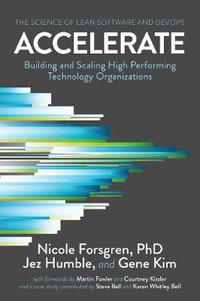
Accelerate
The Science of Lean Software and DevOps: Building and Scaling High Performing Technology Organizations
Paperback
RRP $44.99
$38.90
OFF
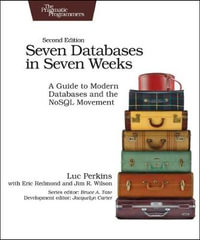
Seven Databases in Seven Weeks : Pragmatic Programmers
A Guide to Modern Databases and the NoSQL Movement : 2nd Edition
Paperback
RRP $91.25
$39.90
OFF
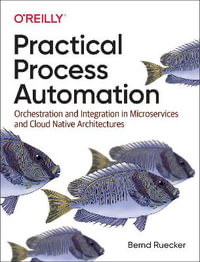
Practical Process Automation
Orchestration and Integration in Microservices and Cloud Native Architectures
Paperback
RRP $125.50
$55.25
OFF
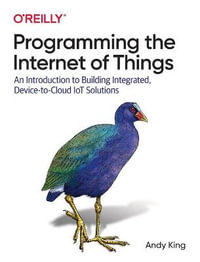
Programming the Internet of Things
An Introduction to Building Integrated, Device-to-Cloud IoT Solutions
Paperback
RRP $152.00
$66.25
OFF

